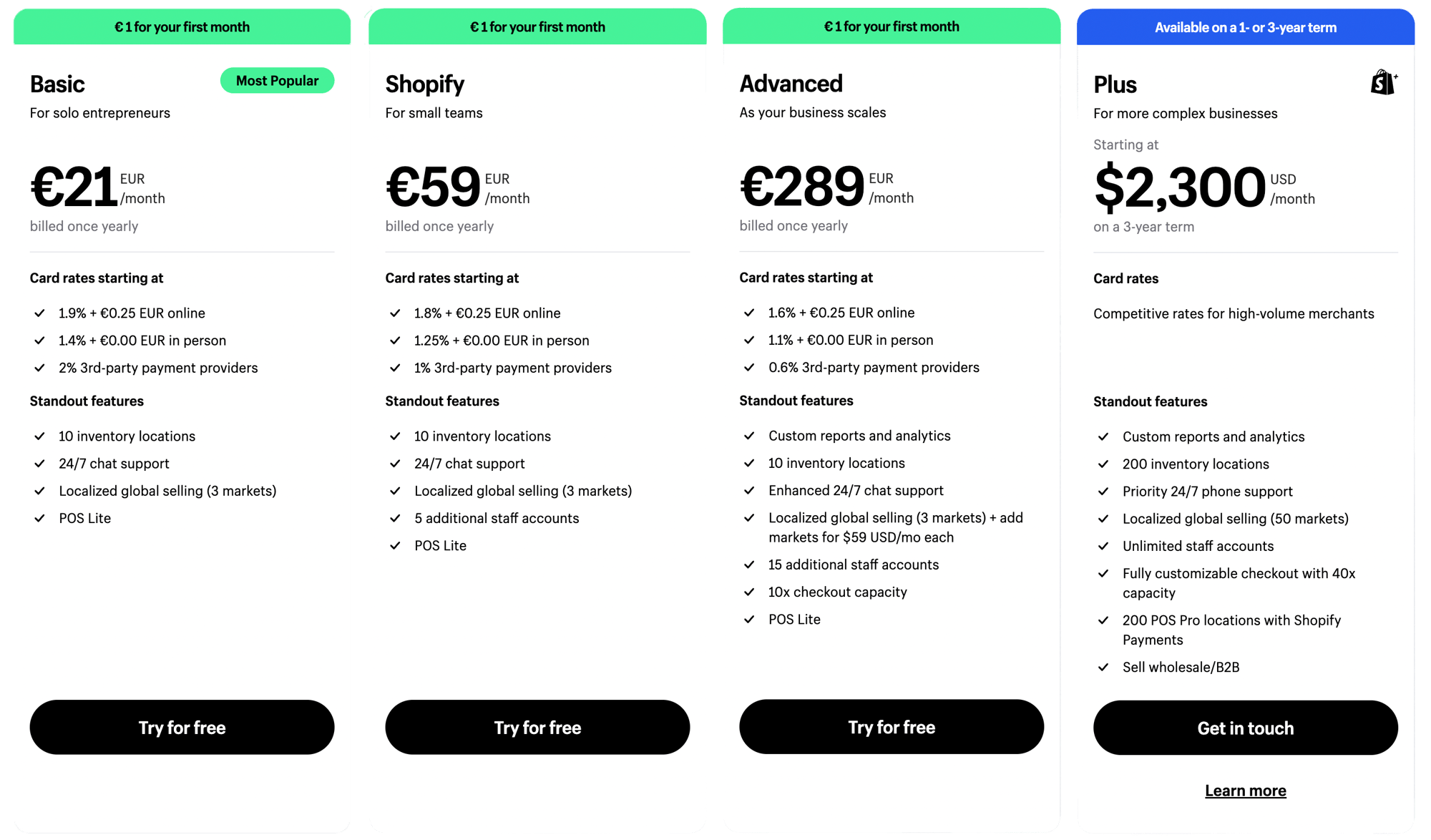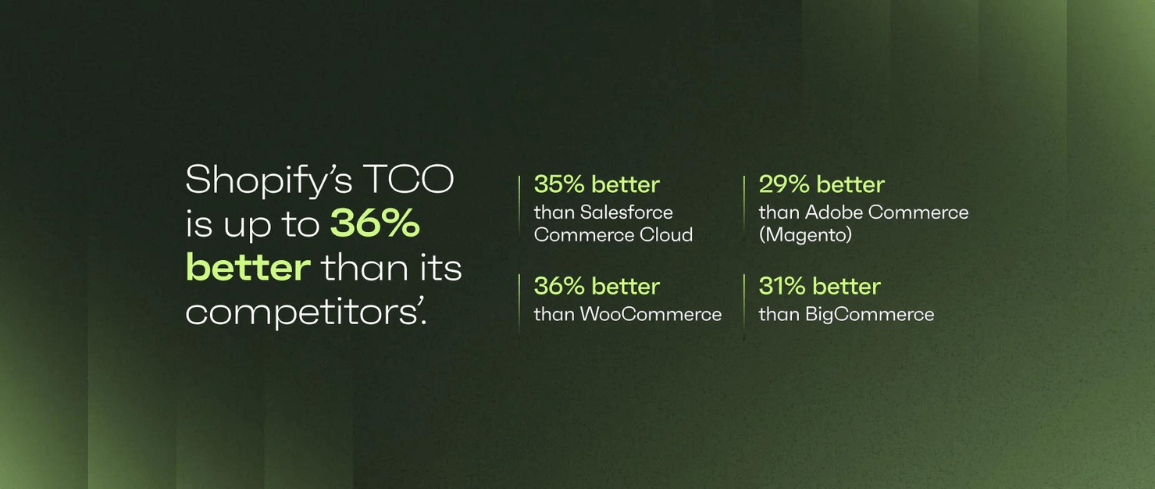
Shopify Plus pricing: variable fee explained
Because the sky is the limit in enterprise e-commerce, the monthly Shopify Plus fee is a fixed minimum. From a certain amount of turnover onwards, it becomes a percentage of your total revenue.
Here’s how it works: the Plus monthly fee is 0.35% (3-year contract) or 0.40% (1-year contract) of your revenue, with a minimum of $2.300 (3-year contract) or $2,500 (1-year contract).
If we do the math on that, we see that the switch from fixed to variable platform fee takes place at a revenue of $657.143 a month. Is your revenue less than $657.143 a month? Then Shopify Plus costs $2.300 a month with a 3-year contract. Do you turn over more than $657.143 a month? Then a Shopify Plus plan costs 0.35% of your revenue.
By asking you to share revenue instead of charging a fixed sum, Shopify allows for your sales figures to fluctuate throughout the year. Even with revenue sharing, Shopify is still cheaper than most competing platforms like Magento, Salesforce Commerce Cloud or Shopware — open source or not. But there’s another argument in favor of the revenue sharing concept: Shopify’s business goals perfectly align with yours: making your brand as successful as possible. Hence, Shopify has a very clear incentive to make its platform as effective as possible.
Transaction fees & Shopify Payments costs
In addition to the platform fee, there are transaction fees to be paid. For every transaction made through your store, a small percentage goes to the Payment Service Provider (PSP) making that transaction possible. Since these are typically the bulk of your costs, it is absolutely worth your while to look into the available PSPs, compare their rates per payment method, and find a set-up that works best for your situation.
When you do this, take note that Shopify encourages merchants to use Shopify Payments, Shopify’s very own PSP, instead of platforms like Mollie, Adyen or Pay.nl. Hence, Shopify charges third-party transaction fees: a commission on sales made through other PSPs, for security and compliance costs. The commission amounts to 0.20% (Shopify Plus) or 0.60% (Shopify Advanced) per transaction - in addition to the transaction fees charged by the external payment provider.
However, for Shopify Plus users who use Shopify Payments as their primary payment provider, the 0.20% commission is waived. As an example, Shopify Plus users who use other PSPs alongside Shopify Payments but process their credit card transactions through Shopify Payments, will not be charged with a commission on sales through external PSP’s.
.png?width=1000&height=250&name=Pricing%20tabel%20(4).png)
If you indeed use Shopify Payments, then the transaction fees listed below apply:%20(1).png?width=1000&height=641&name=Pricing%20tabel%20(1000%20x%20800%20px)%20(1).png)
Some sample calculations
Let’s make the information above a bit more tangible, shall we? Here are a few sample calculations to show you what all this means for the bottom line.
Imagine you have an online store in two languages, which you decided to fully localize instead of translating them through Shopify Markets - hence, you have two separate storefronts. Your yearly turnover is roughly 6 million euros and your AOV is €100, meaning your store processes 60.000 transactions a year. Half of it, including credit card transactions, goes through Shopify Payments, the other half through an external payment provider. What would that cost on the different plans?
Shopify Basic
Yearly subscription fee of €21 x 12 months x 2 stores = € 504
Transaction fees through Shopify Payments €0,25 x 30.000 transactions = €7.500
Transaction fees through Shopify Payments 1.9% of €3 million = €57.000
Commission on sales through external provider 2% of €3 million = €60.000
Total cost: €125.004 per year (excl. transaction fees charged by external provider)
Shopify
Yearly subscription fee of €59 x 12 months x 2 stores = € 1.416
Transaction fees through Shopify Payments €0,25 x 30.000 transactions = €7.500
Transaction fees through Shopify Payments 1.8% of €3 million = €54.000
Commission on sales through external provider 1% of €3 million = €30.000
Total cost: €92.916 per year (excl. transaction fees charged by external provider)
Shopify Advanced
Yearly subscription fee of €289 x 12 months x 2 stores = € 6.936
Transaction fees through Shopify Payments €0,25 x 30.000 transactions = €7.500
Transaction fees through Shopify Payments 1.6% of €3 million = €48.000
Commission on sales through external provider 0.6% of €3 million = €18.000
Total cost: €80.436 per year (excl. transaction fees charged by external provider)
Shopify Plus
Yearly subscription fee (3-year contract) of $2.300 x 12 months = $27.600 ≈ €25.800
Transaction fees through Shopify Payments €0,25 x 30.000 transactions = €7.500
Transaction fees through Shopify Payments 1.4% of €3 million = €42.000
Commission on sales through external provider 0.2% of €3 million = WAIVED (because Shopify Payments is the primary payment provider)
Total cost: €75.300 per year (excl. transaction fees charged by external provider)
As you can see, in this set-up Shopify Plus would cost less than Shopify Advanced, while providing an enterprise-level version of the platform.
The added value of Shopify Plus vs Shopify advanced
You might have noticed the steep increase in monthly costs for the Shopify Plus subscription plan, compared with Shopify Advanced. This is because Shopify Plus targets merchants at enterprise level, and as such offers a host of extra features and functionality.
As a rule, whatever you pay extra for Shopify Plus earns itself back a few times over elsewhere in your business - and not just in the form of lower variable platform fees or payment transaction fees. That is why at Code we often advise our clients to start on Shopify Plus sooner rather than later: it can give your store a huge boost and accelerate your growth.
For instance by making automations a lot easier. Or by offering you ten storefronts instead of just one. Or by adding a suite of B2B functionality, such as customer-specific pricing and minimum order quantities, at no extra cost - or extended versions of Shopify Markets and Shopify POS that will make your business a lot more scalable. And let’s not forget Checkout Extensibility: the option to optimize your checkout’s conversion with things like upsell and cross-sell possibilities, or customer-specific discounts.
Here is an overview of the extra features that are included in a Shopify Plus subscription:
- Up to 10 storefronts (and even more for a small fee)
- Up to 25 headless storefronts
- Infinite scalability: process up to 10.000 transactions per minute
- Unlimited employee accounts
- Supports up to 200 inventory locations
- Priority support from Shopify via phone or live chat
- B2B on Shopify: combine your D2C and wholesale channels in a single dashboard
- Shopify Markets Pro: launch your products in 50 new markets (instead of the 3 offered in the other plans)
- Shopify POS Pro: Shopify’s point-of-sale tool, but make it enterprise. POS Pro supports 20 locations, or 200 if you use Shopify Payments. On a Shopify Plus subscription, Shopify POS Pro is free. For other subscription plans it costs €79 a month.
- Checkout Extensibility: customize your checkout
- Shopify Audiences: find your future brand ambassadors
- Bot protection: protects your store from bots during flash sales
- Launchpad: automate promotions, product releases and store updates
- Shopify Functions: design and implement your own custom apps
- ShopifyQL Notebooks: visualize and analyze your data better
- Shopify Plus Certified App Partners: access to apps that cater to complex enterprise needs
- Shopify Academy: access to workshops and courses that help you scale on Shopify Plus
→ Read more about the reasons to choose Shopify Plus vs Shopify Advanced
When to switch to Shopify Plus
So where is the tipping point when it pays off to upgrade from Shopify Advanced to Shopify Plus? In our experience, this can already be a viable move at a revenue of €200.000 a month, or €2.4 million a year.
At that point, there is still quite a gap - but as we said earlier, this gap is more than made up for with the value Shopify Plus adds elsewhere in your business. Especially when you are about to expand internationally, or need features like Shopify POS Pro, B2B for Shopify, a customizable checkout, or a number of headless storefronts. Having this functionality custom built far exceeds the cost of your Shopify Plus subscription - so you can save yourself a lot of time and hassle by simply upgrading.
→ Curious what tipping point we advise for your business? Get in touch for our expert advice.
Costs of building a Shopify store
Of course your monthly fee and your transaction costs aren’t the only expenses you will have when running a Shopify store. The store also has to be built and set up.
What does it cost to have your Shopify store built, by an official Shopify Premier partner? To give you an idea, at Code our clients generally fall into these three categories:
- Base (40-50k euros) - like the store of our clients DOUXE and SNURK
- Advanced (50-100k) - like the store of our clients namuk, BOSKA and Muchachomalo
- Enterprise (100-300k) - like the stores of our client Alpinestars
In addition to the initial build costs, you will have recurring costs for things like Shopify apps, Shopify integrations, domain names, localization of content, email marketing with Klaviyo, social media accounts, marketplace fees, and so on.
Calculate your E-commerce Total Cost of Ownership
To get the best insight into the cost of running your online business on Shopify, make sure you look into Total Cost of Ownership. At Code we cannot stress enough how important it is to know your TCO: so we made a TCO calculator to help you. Read our blog about TCO, put your numbers in the calculator and it will give you a monthly estimate over a three-year period.
Shopify cost vs cost of other platforms
Are you on another platform than Shopify? And would you like to compare your current platform with Shopify to see if migrating is a smart move for you? Of course you can use our TCO calculator to see how much Shopify would cost for your current setup - but it cannot tell you what your TCO is on your current platform.
Code can help you with that, and if you contact us we will gladly do the numbers for you. But to give you an estimate already: check out the results of a study Shopify commissioned on TCO here. The study compared TCO across some major e-commerce platforms in the USA, and the outcome is pretty straightforward: on average, Shopify’s TCO is up to 36% better than its competitors’.

Priceless: expert help and advice
Running and scaling an online store of some size is a complex undertaking, and having an expert to guide you through it all will save you a lot of time and money. If you start calculating the overall cost of your store, make sure to factor in expert advice - it will earn itself back a few times over in the same way a Shopify Plus subscription will.
This is where Code comes in as an experienced and dependable growth partner for our clients. Tap into our wide knowledge of Shopify, and let us help you grow and scale your online business in a futureproof way.





.png)